battery RENAULT SCENIC 2009 J84 / 2.G Engine And Peripherals EDC16 Owner's Manual
[x] Cancel search | Manufacturer: RENAULT, Model Year: 2009, Model line: SCENIC, Model: RENAULT SCENIC 2009 J84 / 2.GPages: 273
Page 179 of 273
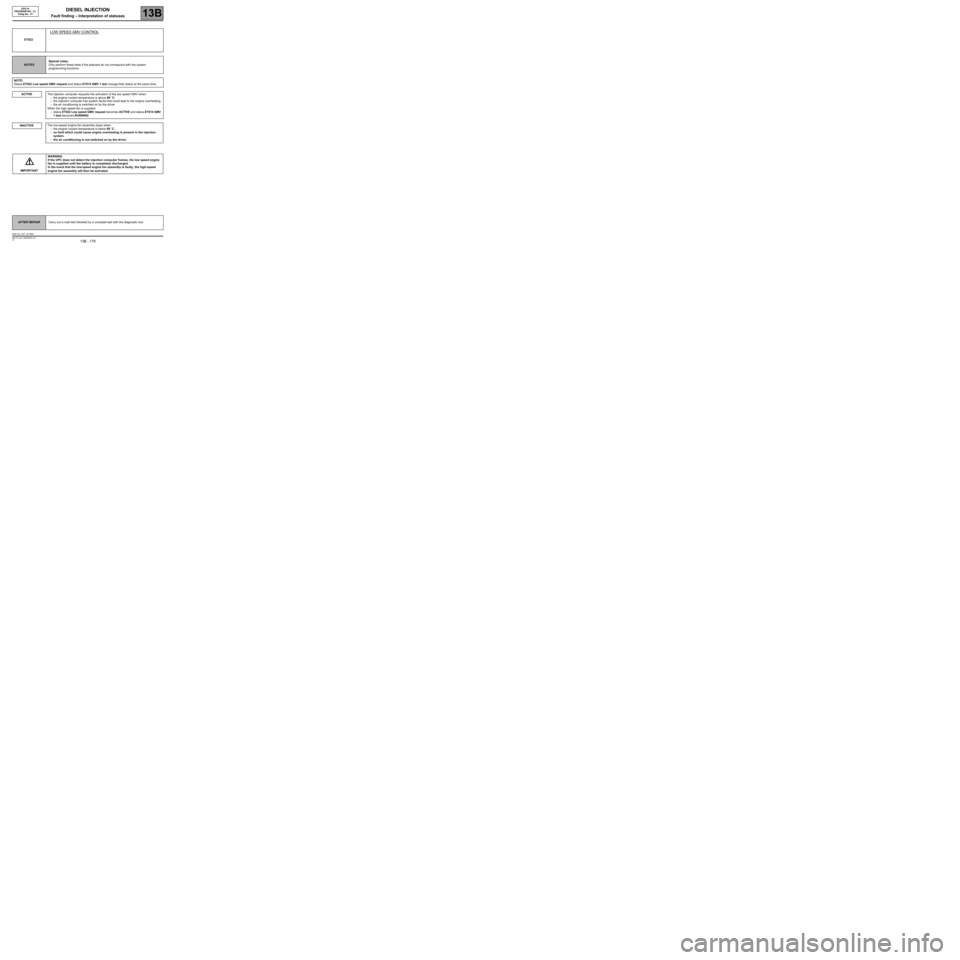
DIESEL INJECTION
Fault finding – Interpretation of statuses13B
13B - 179V3 MR-372-J84-13B250$630.mif
INACTIVE
EDC16
PROGRAM NO.: C1
Vdiag No.: 51
ET022
LOW SPEED GMV CONTROL
NOTESSpecial notes:
Only perform these tests if the statuses do not correspond with the system
programming functions.
NOTE:
Status ET022 Low speed GMV request and status ET014 GMV 1 test change their status at the same time.
ACTIVE
The injection computer requests the activation of the low speed GMV when:
–the engine coolant temperature is above 89 ˚C;
–the injection computer has system faults that could lead to the engine overheating,
–the air conditioning is switched on by the driver.
When the high speed fan is supplied:
–status ET022 Low speed GMV request becomes ACTIVE and status ET014 GMV
1 test becomes RUNNING.
The low-speed engine fan assembly stops when:
–the engine coolant temperature is below 89 ˚C;
–no fault which could cause engine overheating is present in the injection
system.
–the air conditioning is not switched on by the driver.
IMPORTANTWARNING
If the UPC does not detect the injection computer frames, the low speed engine
fan is supplied until the battery is completely discharged.
In the event that the low-speed engine fan assembly is faulty, the high-speed
engine fan assembly will then be activated.
AFTER REPAIRCarry out a road test followed by a complete test with the diagnostic tool.
EDC16_V51_ET022
Page 201 of 273
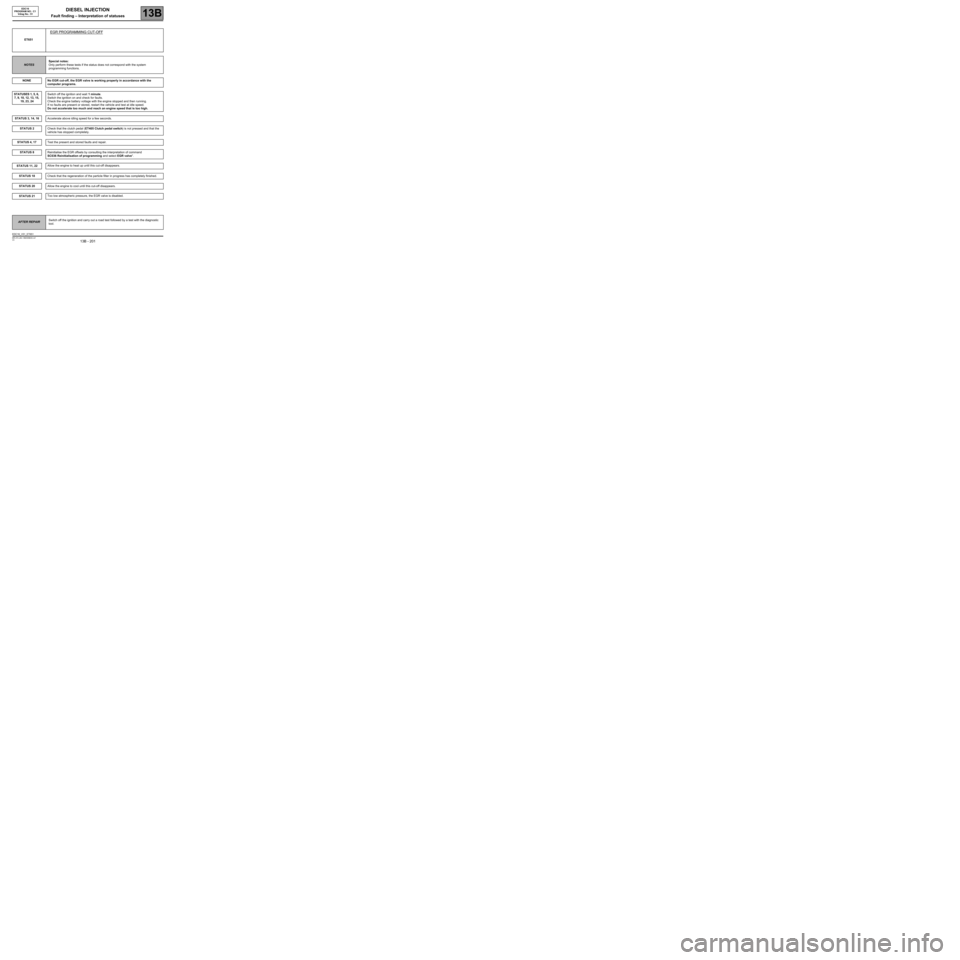
DIESEL INJECTION
Fault finding – Interpretation of statuses13B
13B - 201V3 MR-372-J84-13B250$630.mif
STATUS 18
STATUS 20
STATUS 21
STATUS 11, 22
STATUS 8
STATUS 4, 17
STATUS 2
STATUS 3, 14, 16
STATUSES 1, 5, 6,
7, 9, 10, 12, 13, 15,
19, 23, 24
EDC16
PROGRAM NO.: C1
Vdiag No.: 51
ET651
EGR PROGRAMMING CUT-OFF
NOTESSpecial notes:
Only perform these tests if the status does not correspond with the system
programming functions.
NONE
No EGR cut-off, the EGR valve is working properly in accordance with the
computer programs.
Switch off the ignition and wait 1 minute.
Switch the ignition on and check for faults.
Check the engine battery voltage with the engine stopped and then running.
If no faults are present or stored, restart the vehicle and test at idle speed.
Do not accelerate too much and reach an engine speed that is too high.
Accelerate above idling speed for a few seconds.
Check that the clutch pedal (ET405 Clutch pedal switch) is not pressed and that the
vehicle has stopped completely.
Test the present and stored faults and repair.
Reinitialise the EGR offsets by consulting the interpretation of command
SC036 Reinitialisation of programming and select EGR valve".
Allow the engine to heat up until this cut-off disappears.
Check that the regeneration of the particle filter in progress has completely finished.
Allow the engine to cool until this cut-off disappears.
Too low atmospheric pressure, the EGR valve is disabled.
AFTER REPAIRSwitch off the ignition and carry out a road test followed by a test with the diagnostic
tool.
EDC16_V51_ET651
Page 215 of 273
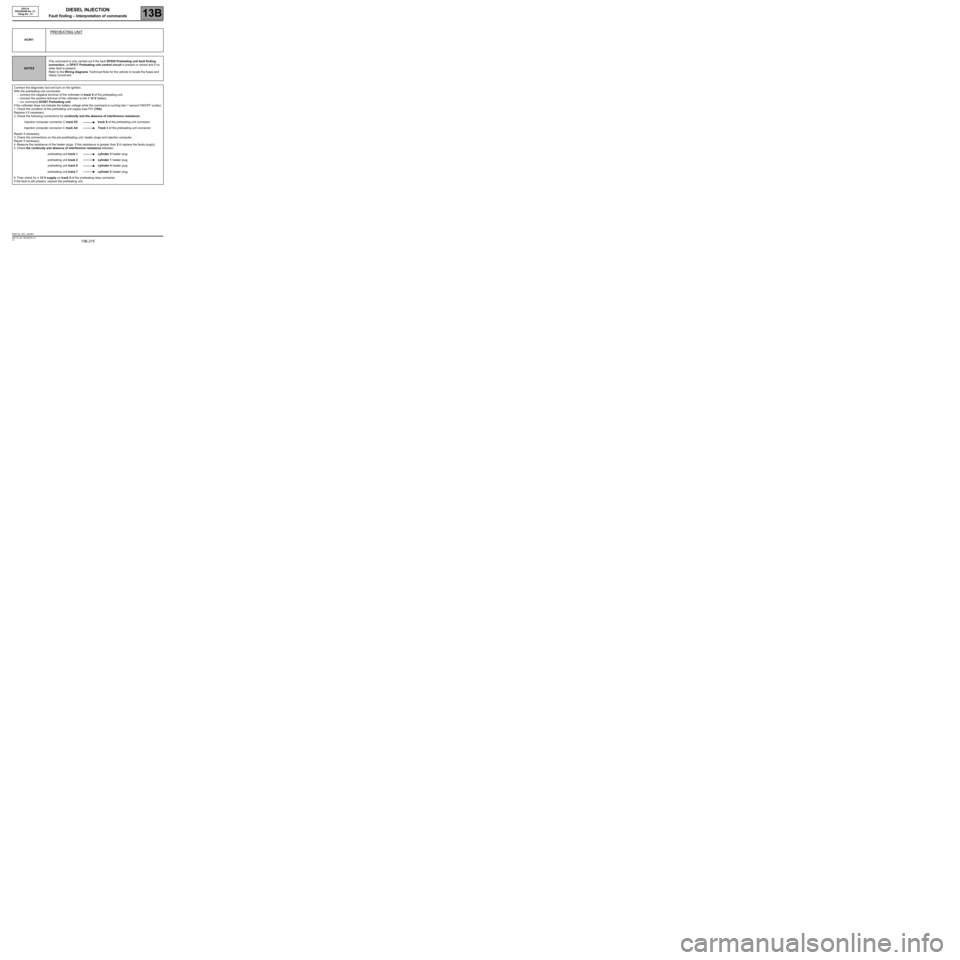
DIESEL INJECTION
Fault finding – Interpretation of commands13B
13B -215V3 MR-372-J84-13B250$765.mif
EDC16
PROGRAM No: C1
Vdiag No.: 51
AC001
PREHEATING UNIT
NOTESThis command is only carried out if the fault DF025 Preheating unit fault finding
connection, or DF017 Preheating unit control circuit is present or stored and if no
other fault is present.
Refer to the Wiring diagrams Technical Note for the vehicle to locate the fuses and
relays concerned.
Connect the diagnostic tool and turn on the ignition.
With the preheating unit connected:
–connect the negative terminal of the voltmeter to track 8 of the preheating unit,
–connect the positive terminal of the voltmeter to the + 12 V battery,
–run command AC001 Preheating unit.
if the voltmeter does not indicate the battery voltage while the command is running (ten 1 second ON/OFF cycles):
1Check the condition of the preheating unit supply fuse F01 (70A).
Replace it if necessary.
2Check the following connections for continuity and the absence of interference resistance:
Injection computer connector C track E2 track 8 of the preheating unit connector
Injection computer connector C track A4 Track 3 of the preheating unit connector
Repair if necessary.
3Check the connections on the pre-postheating unit, heater plugs and injection computer.
Repair if necessary.
4Measure the resistance of the heater plugs. If this resistance is greater than 2 Ω replace the faulty plug(s).
5Check the continuity and absence of interference resistance between:
preheating unit track 1 cylinder 3 heater plug
preheating unit track 2 cylinder 1 heater plug
preheating unit track 6 cylinder 4 heater plug
preheating unit track 7 cylinder 2 heater plug.
6Then check for + 12 V supply on track 4 of the preheating relay connector.
If the fault is still present, replace the preheating unit.
EDC16_V51_AC001
Page 217 of 273
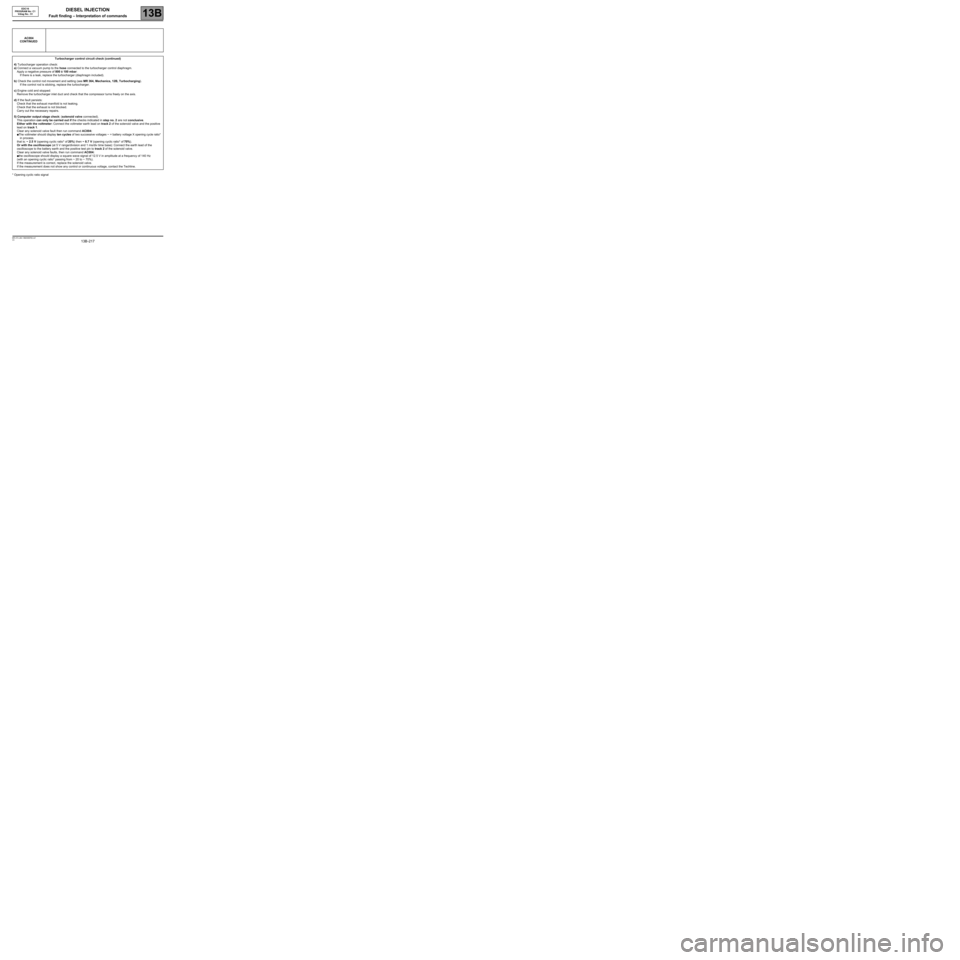
DIESEL INJECTION
Fault finding – Interpretation of commands13B
13B -217V3 MR-372-J84-13B250$765.mif
EDC16
PROGRAM No: C1
Vdiag No.: 51
* Opening cyclic ratio signalAC004
CONTINUED
Turbocharger control circuit check (continued)
4) Turbocharger operation check:
a) Connect a vacuum pump to the hose connected to the turbocharger control diaphragm.
Apply a negative pressure of 800 ± 100 mbar:
If there is a leak, replace the turbocharger (diaphragm included).
b) Check the control rod movement and setting (see MR 364, Mechanics, 12B, Turbocharging).
If the control rod is sticking, replace the turbocharger.
c) Engine cold and stopped:
Remove the turbocharger inlet duct and check that the compressor turns freely on the axis.
d) If the fault persists:
Check that the exhaust manifold is not leaking.
Check that the exhaust is not blocked.
Carry out the necessary repairs.
5) Computer output stage check: (solenoid valve connected).
This operation can only be carried out if the checks indicated in step no. 2 are not conclusive.
Either with the voltmeter: Connect the voltmeter earth lead on track 2 of the solenoid valve and the positive
lead on track 1.
Clear any solenoid valve fault then run command AC004:
●The voltmeter should display ten cycles of two successive voltages ~ = battery voltage X opening cycle ratio*
in process.
that is: ~ 2.5 V (opening cyclic ratio* of 20%) then ~ 8.7 V (opening cyclic ratio* of 70%).
Or with the oscilloscope (at 5 V range/division and 1 ms/div time base): Connect the earth lead of the
oscilloscope to the battery earth and the positive test pin to track 2 of the solenoid valve.
Clear any solenoid valve faults, then run command AC004:
●the oscilloscope should display a square wave signal of 12.5 V in amplitude at a frequency of 140 Hz
(with an opening cyclic ratio* passing from ~ 20 to ~ 70%).
If the measurement is correct, replace the solenoid valve.
If the measurement does not show any control or continuous voltage, contact the Techline.
Page 218 of 273
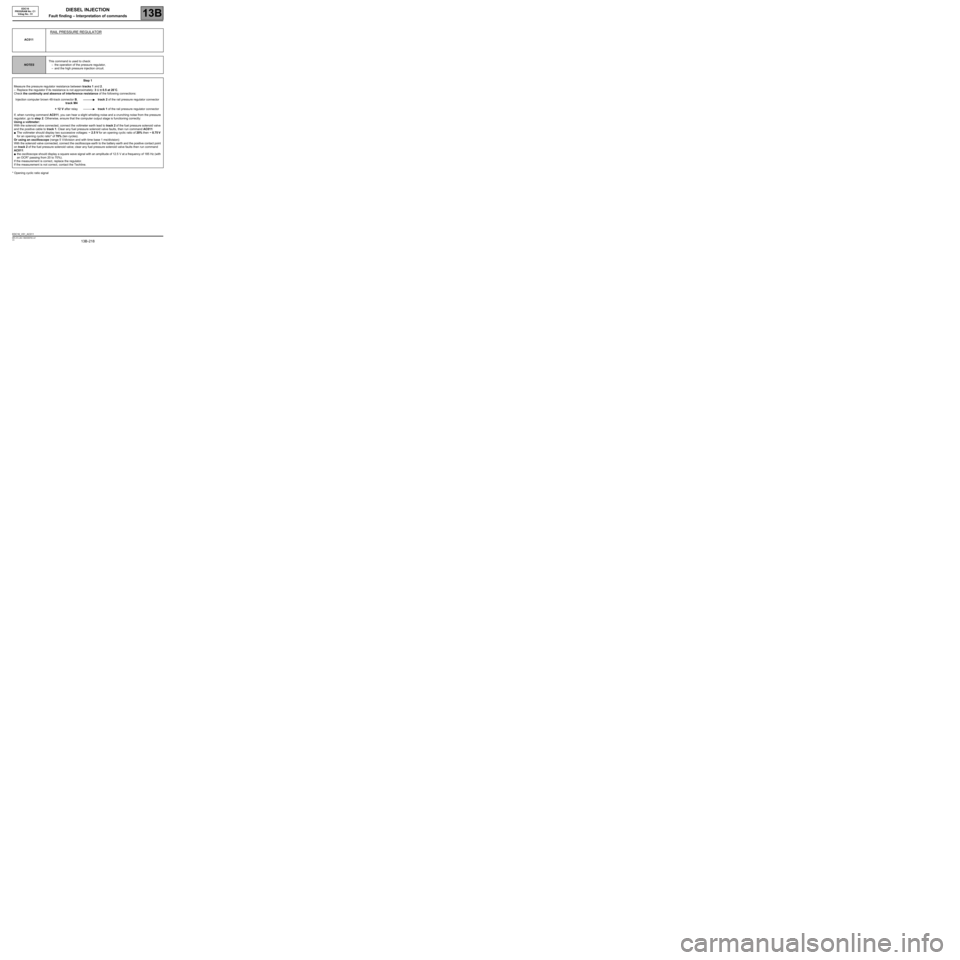
DIESEL INJECTION
Fault finding – Interpretation of commands13B
13B -218V3 MR-372-J84-13B250$765.mif
EDC16
PROGRAM No: C1
Vdiag No.: 51
* Opening cyclic ratio signalAC011
RAIL PRESSURE REGULATOR
NOTESThis command is used to check:
–the operation of the pressure regulator,
–and the high pressure injection circuit.
Step 1
Measure the pressure regulator resistance between tracks 1 and 2.
–Replace the regulator if its resistance is not approximately: 3 Ω ± 0.5 at 20˚C.
Check the continuity and absence of interference resistance of the following connections:
Injection computer brown 48-track connector B,
track M4track 2 of the rail pressure regulator connector
+ 12 V after relaytrack 1 of the rail pressure regulator connector
If, when running command AC011, you can hear a slight whistling noise and a crunching noise from the pressure
regulator, go to step 2. Otherwise, ensure that the computer output stage is functioning correctly:
Using a voltmeter:
With the solenoid valve connected, connect the voltmeter earth lead to track 2 of the fuel pressure solenoid valve
and the positive cable to track 1. Clear any fuel pressure solenoid valve faults, then run command AC011:
●The voltmeter should display two successive voltages: ~ 2.5 V for an opening cyclic ratio of 20% then ~ 8.75 V
for an opening cyclic ratio* of 70% (ten cycles).
Or using an oscilloscope (range 5 V/division and with time base 1 ms/division):
With the solenoid valve connected, connect the oscilloscope earth to the battery earth and the positive contact point
on track 2 of the fuel pressure solenoid valve; clear any fuel pressure solenoid valve faults then run command
AC011:
●the oscilloscope should display a square wave signal with an amplitude of 12.5 V at a frequency of 185 Hz (with
an OCR* passing from 20 to 70%).
If the measurement is correct, replace the regulator.
If the measurement is not correct, contact the Techline.
EDC16_V51_AC011
Page 223 of 273
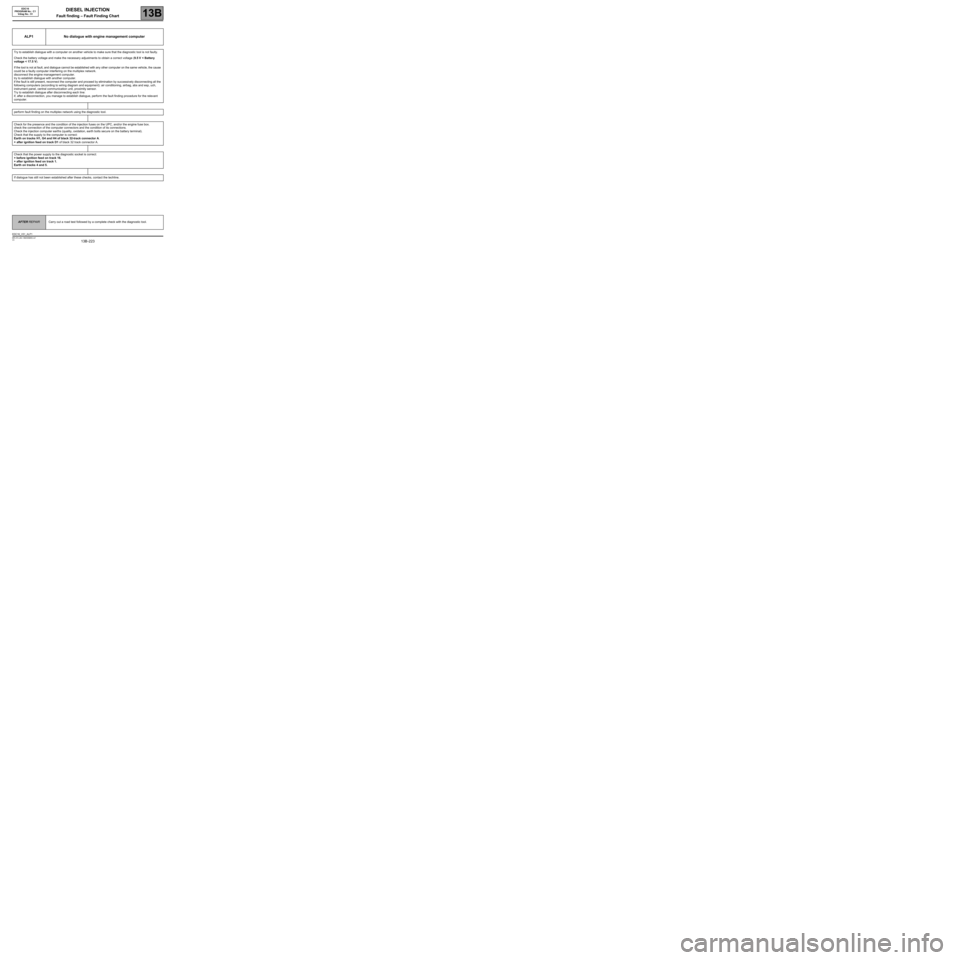
DIESEL INJECTION
Fault finding – Fault Finding Chart13B
13B -223V3 MR-372-J84-13B250$855.mif
EDC16
PROGRAM No.: C1
Vdiag No.: 51DIESEL INJECTION
Fault finding – Fault Finding Chart
ALP1 No dialogue with engine management computer
Try to establish dialogue with a computer on another vehicle to make sure that the diagnostic tool is not faulty.
Check the battery voltage and make the necessary adjustments to obtain a correct voltage (9.5 V < Battery
voltage < 17.5 V).
If the tool is not at fault, and dialogue cannot be established with any other computer on the same vehicle, the cause
could be a faulty computer interfering on the multiplex network.
disconnect the engine management computer.
try to establish dialogue with another computer.
if the fault is still present, reconnect the computer and proceed by elimination by successively disconnecting all the
following computers (according to wiring diagram and equipment): air conditioning, airbag, abs and esp, uch,
instrument panel, central communication unit, proximity sensor.
Try to establish dialogue after disconnecting each line:
if, after a disconnection, you manage to establish dialogue, perform the fault finding procedure for the relevant
computer.
perform fault finding on the multiplex network using the diagnostic tool.
Check for the presence and the condition of the injection fuses on the UPC, and/or the engine fuse box.
check the connection of the computer connectors and the condition of its connections.
Check the injection computer earths (quality, oxidation, earth bolts secure on the battery terminal).
Check that the supply to the computer is correct:
Earth on tracks H1, G4 and H4 of black 32-track connector A.
+ after ignition feed on track D1 of black 32 track connector A.
Check that the power supply to the diagnostic socket is correct:
+ before ignition feed on track 16.
+ after ignition feed on track 1.
Earth on tracks 4 and 5.
If dialogue has still not been established after these checks, contact the techline.
AFTER REPAIRCarry out a road test followed by a complete check with the diagnostic tool.
EDC16_V51_ALP1
Page 248 of 273
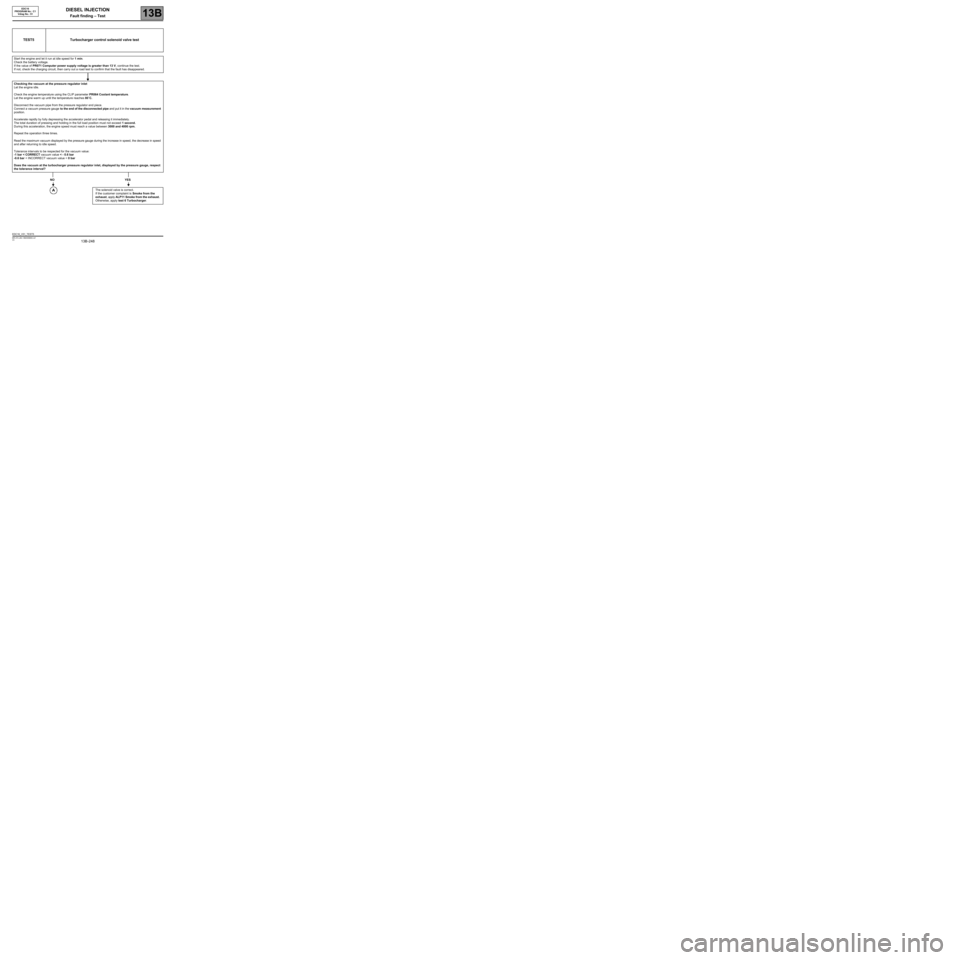
DIESEL INJECTION
Fault finding – Test13B
13B -248V3 MR-372-J84-13B250$900.mif
EDC16
PROGRAM No.: C1
Vdiag No.: 51
TEST5 Turbocharger control solenoid valve test
Start the engine and let it run at idle speed for 1 min.
Check the battery voltage.
If the value of PR071 Computer power supply voltage is greater than 13 V, continue the test.
If not, check the charging circuit, then carry out a road test to confirm that the fault has disappeared.
Checking the vacuum at the pressure regulator inlet
Let the engine idle.
Check the engine temperature using the CLIP parameter PR064 Coolant temperature.
Let the engine warm up until the temperature reaches 80˚C.
Disconnect the vacuum pipe from the pressure regulator end piece.
Connect a vacuum pressure gauge to the end of the disconnected pipe and put it in the vacuum measurement
position.
Accelerate rapidly by fully depressing the accelerator pedal and releasing it immediately.
The total duration of pressing and holding in the full load position must not exceed 1 second.
During this acceleration, the engine speed must reach a value between 3000 and 4000 rpm.
Repeat the operation three times.
Read the maximum vacuum displayed by the pressure gauge during the increase in speed, the decrease in speed
and after returning to idle speed.
Tolerance intervals to be respected for the vacuum value:
-1 bar < CORRECT vacuum value < - 0.6 bar
-0.6 bar < INCORRECT vacuum value < 0 bar
Does the vacuum at the turbocharger pressure regulator inlet, displayed by the pressure gauge, respect
the tolerance interval?
NO YES
The solenoid valve is correct.
If the customer complaint is Smoke from the
exhaust, apply ALP11 Smoke from the exhaust.
Otherwise, apply test 6 Turbocharger.
1
EDC16_V51_TEST5
Page 273 of 273
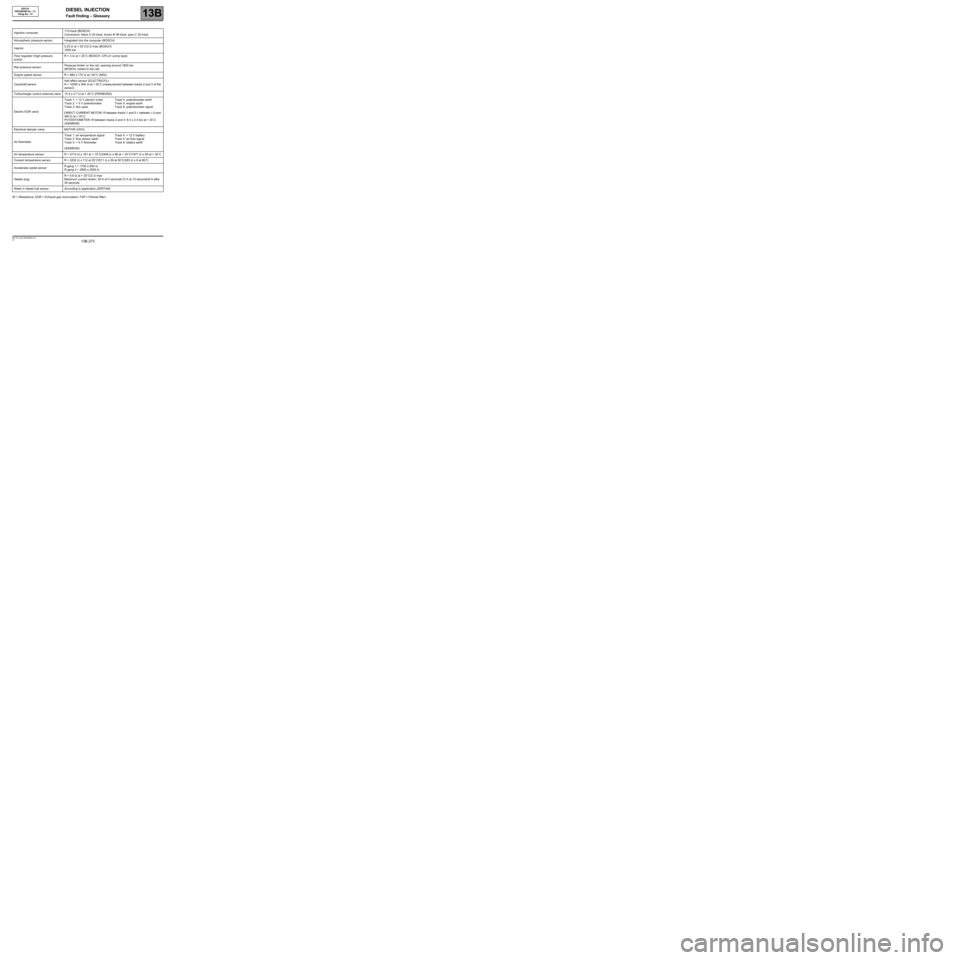
DIESEL INJECTION
Fault finding – Glossary13B
13B -273V3 MR-372-J84-13B250$945.mif
EDC16
PROGRAM No.: C1
Vdiag No.: 51DIESEL INJECTION
Fault finding – Glossary
(R = Resistance, EGR = Exhaust gas recirculation, FAP = Particle filter)Injection computer112-track (BOSCH)
Connectors: black A 32-track, brown B 48-track, grey C 32-track
Atmospheric pressure sensor Integrated into the computer (BOSCH)
Injector0.23 Ω at + 20˚C/2 Ω max (BOSCH)
1600 bar
Flow regulator (high pressure
pump)R = 3 Ω at + 20˚C (BOSCH, CP3.2+ pump type)
Rail pressure sensorPressure limiter on the rail: opening around 1800 bar
(BOSCH, bolted to the rail)
Engine speed sensor R = 680 ± 170 Ω at +20˚C (MGI)
Camshaft sensorHall effect sensor (ELECTRICFIL)
R = 10250 ± 500 Ω at + 20˚C (measurement between tracks 2 and 3 of the
sensor)
Turbocharger control solenoid valve 15.4 ± 0.7 Ω at + 20˚C (PIERBURG)
Electric EGR valveTrack 1: + 12 V electric motor
Track 2: + 5 V potentiometer
Track 3: Not usedTrack 4: potentiometer earth
Track 5: engine earth
Track 6: potentiometer signal
DIRECT CURRENT MOTOR: R between tracks 1 and 5 = between 1 Ω and
400 Ω at + 20˚C
POTENTIOMETER: R between tracks 2 and 4: 6.5 ± 2.4 kΩ at + 20˚C
(SIEMENS)
Electrical damper valve MOTOR (VDO)
Air flowmeterTrack 1: air temperature signal
Track 2: flow sensor earth
Track 3: + 5 V flowmeterTrack 4: + 12 V battery
Track 5: air flow signal
Track 6: battery earth
(SIEMENS)
Air temperature sensor R = 3714 Ω ± 161 at + 10˚C/2448 Ω ± 96 at + 20˚C/1671 Ω ± 59 at + 30˚C
Coolant temperature sensor R = 2252 Ω ± 112 at 25˚C/811 Ω ± 39 at 50˚C/283 Ω ± 8 at 80˚C
Accelerator pedal sensorR gang 1 = 1700 ± 900 Ω;
R gang 2 = 2850 ± 2050 Ω
Heater plugR = 0.6 Ω at + 20˚C/2 Ω max
Maximum current drawn: 28 A at 0 seconds/12 A at 10 seconds/9 A after
30 seconds
Water in diesel fuel sensor According to application (ZERTAN)